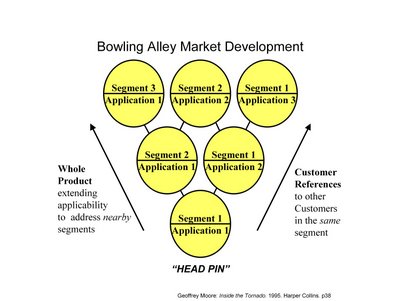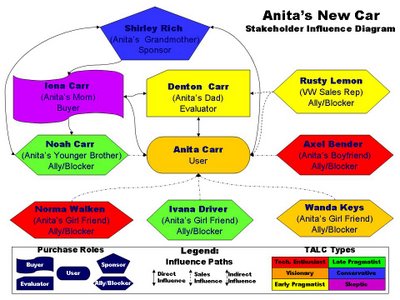Early Pragmatists, Head Pins, and the Bowling Alley
To avoid the Chasm, it is critical to quickly make some sales to a few Early Pragmatists that can act as references to others.
A typical Early Pragmatist in the high technology world might be a Chief Information Officer. Early Pragmatists are more concerned with risk avoidance than the Visionaries and Technology Enthusiasts. They want to build a solution for the long run, and so they want to find technologies that adhere to an enacted or de facto standard.
Entering a market at the beginning of the Bowling Alley phase takes a set of skills very different from those which will allow a company to continue to grow after it is established. It is these special skills that distinguishSWIFT from most Product Development and Marketing strategy taught at business schools. Because the majority of business school graduates will spend most of their careers growing products at established companies with existing successful product lines and brand awareness, SWIFTs special focus may not be relevant to them.
However, for the venture capital funded Entrepreneur these differences are critical to success.
D-Day and the importance of Niches
Moore has drawn an apt analogy between entering the market in the Bowling Alley phase and the D-Day invasion of continental Europe.
Military strategy (and military history) demonstrates that the winner of any battle is almost always determined by whether the attacker has an overwhelming numerical force at the location where the battle takes place. This poses a special problem for the military planner who has only a smaller force and must engage a far superior force that is already well entrenched.
Such a situation existed in Northern Europe prior to D-Day in World War II. Germany's huge armed forces had command of all of Continental Europe, while US and British Allied Forces were stuck across the channel.
The Allies did not have sufficient forces to outnumber German continental forces, a seemingly impossible feat. However, because those forces had to defend all of the Western front they were necessarily spread thin. And that is the key to the Allies strategy. Rather than attack all of Europe at once, the Allies could do is is put an overwhelming number of forces in a single location, a beach head called Normandy.
Having successfully invaded Normandy, the Allies could land yet more forces, and then focus these additional on yet other nearby locations where they could outnumber the German forces. Battle by battle the Allies expanded their sphere of control, until they successfully defeated Germany.
The parallel to business is striking. A small start-up can not take on a much larger established and entrenched incumbent in it's main market. But it can win by concentrating all its forces on a small niche where the larger company is spread thin. And having established its dominance in that first niche it attacks other niches nearby.
Moore likens this growth into nearby areas to a set of bowling pins. First you have to knock off the head pin, and that helps you knock over pins 2 and 3, and then those pins in turn knock over pins 4, 5, and 6 and so on. For this reason, Moore calls this Early Pragmatist market, the Bowling Alley.
As you can see, in this model the head pin is critical to successfully crossing the Chasm and building a set of references among the Early Pragmatists that in turn can be used to grow the market.
As a new entrant we will have to do that with out the power of an established brand, an established sales channel, and tried and true operational methods tuned to our specific customers. We may not know who their customers are, or even what our market niche should be, until we achieve "sales traction".
But we can identify which kinds of markets and customers could be won, and having been won, would enable us to win others in the same niche.
The key strategy here is that the target niche must be composed of people who talk with each other. The one thing that would make it easier to sell to an Early Pragmatist is a success story about some other Early Pragamatist just like them. The prospects awareness of the reference customer makes up for their lack of awareness of the new entrant. Credibility is established not through what the new entrant claims the product will do, but what the reference customers have demonstrated it will do.
If the stakeholders in the target niche regularly communicate with each other, word of mouth praise will become the new entrant's strongest weapon. So these are the kinds of market segments we wish to target. Customer 1 tells Customer 2 who tells Customer 3, etc.
Of course, there is one problem with this model, why does Customer 1 buy? They have no pre-existing success story to influence them.
Moore's answer is that Customer 1 must have no other reasonable alternative. Unless they buy, they know for sure that they will not achieve their business objectives. But if they can see a demonstration that proves to them that they have a good chance of achieving their goal by using the new product, they may give it a shot. It is thus critically important that all the company's forces be dedicated to ensuring that first customer success.
Next, by focussing all their energy on other nearby customers in the same niche, they can use that word of mouth advertising to become the gorilla in that small niche.
This niche becomes what Moore calls the "Head Pin" in his bowling alley analogy. The company's reputation in the head pin market is then leveraged to hit other nearby niches as well. Moore shows that there is the possibility to expand from our beach head or head pin in two ways, other products that solve other problems for the same customers (industry focussed expansion) as well as by applying the technology to the same sort of problem as before, but in nearby industries:

Having successfully won our chosen beach head, we can now attack nearby niche's. To be successful at this, we need to take that reputation we have with their first custome(s) and make the new customers aware of this leadership. Our message will be some variant of "the acknowledged leader in the ABC market, now has a solution for the DEF market. We need strategies for generating this marketing awareness and establishing our leadership position. To this end, we will talk about how to use Zoom Marketing Corporation's The Point That Matters model to achieve these goals, and that will be a topic of a future post. For now, let us just identify that the new entrant grows not with a horizontal product, but by winning individual "nearby" niches and then assembling them together into a larger market..
Late Pragmatists and the Tornado
Because Pragmatists are herd animals, once a sizable set in a market begins to settle on one particular vendor or product, others rapidly follow. The leaders product becomes the de facto standard. Late pragmatists, who hung back waiting to see which standard would emerge suddenly, commit themselves. At this point, it is critical to become the market leader, and sales spiral upward at a furious rate. Moore calls this the Tornado market.
Conservatives and the Main Street market
After a product has achieved market success and starts to mature, Conservatives are willing to buy the product. Conservatives can be anywhere in the organization, but are typically managers in end user departments.
While the Pragmatists were buying to solve a problem or take advantage of a new capability, Conservatives are motivated by the need to stay competitive. It is the fact that most of the other competitors already have these products and are getting benefits from them that drives the Conservative to purchase. This is the Main Streetmarket. Price becomes more important, as does added services and extensions that customize the product for a particular customer. But these customizations are radically different from what the Visionary was interested in. The visionary knew what technology they wanted and specified this to the seller. The Conservative on the other hand has no interest in figuring out what technologies are needed and how they should be arrayed.Rather the Conservative wants an off the shelf complete solution, including installation and maintenance services.
Skeptics and the End of Life market
As the market matures further it becomes saturated most everyone who will want the product has one already or the technology starts to be supplanted by new technologies. The remaining purchasers are the Skeptics in this End of Life market phase. These can be end users, or user department managers, or sometimes information technology staff assigned to maintaining legacy systems.
The Skeptics are normally reluctant to make a purchase except to prolong the life of purchases they have already made. For this reason, Skeptics are likely to buy maintenance on existing products they have, converters and interfaces that allow their existing products to work with newer technologies, rather than replacing those products.
Something of every type in all of us
Readers who are not already familiar with this methodology might conclude that any given person is a specificbuyer type: either a technology enthusiast, or a visionary, or a pragmatist, etc. This is not really the case, we all adopt different buyer preferences for different kinds of products. For instance, David might be a technology enthusiast when it comes to home audio-video equipment, and a visionary with respect to telecommunications such as cellular phones or pagers. But when it comes to buying kitchen appliances he may be a pragmatist buying only to meet specific problems and focusing on brands that have name recognition. When it comes to his clothing he is conservative, only discarding unfashionable suits and ties when they have become so old fashioned or worn as to call negative attention to him. And his 12-year-old car is babied along in skeptic fashion, with regular oil changes, car washes, and engine maintenance.
As we saw before, there are typically multiple people involved in any major purchase, and in all likelihood they will be distributed across the buyer types. In our car purchase example, Anita's boy friend, Axel, might have be a Technology Enthusiast, her father, Denton, might be a Pragmatist, her grandmother, Shirley, a Conservative, and her mother, Iona might be a Skeptic, with Jane playing a Visionary.
No one product can be all things to all people, and the car ultimately chosen was not the top preference of every person. But what was critical was that the product
- acceptably met the goals of many of the Influencers,
- was not rejected outright by any of the major decision makers (Mom, Dad and Jane), and
- was a 100% solution to the main buyers problems (Jane).
So now we have the means to further annotate our Stakeholder chart:

No single right market
It is worth stressing again that ultimately there is no single right market for an established company to focus on in the Technology Adoption Life Cycle. While the size of the Conservatives market is larger than the size of the Visionaries market, the price sensitivity is higher there and so margins may be much lower. Companies like Computer Associates dominate the Skeptics markets and make a lot of money in services and maintenance with very little expenses in engineering and new product development. Teknowledge Corporation's primary customers, have included the Defense Advanced Research Projects Agency (DARPA), a classic Technology Enthusiast and Visionary organization. IBM, once the giant amongst the Pragmatists is now showing its clout in the Conservatives market place with sales and services to small companies. Sun Microsystems achieved huge success by establishing its products as open systems standards thus taking the Pragmatists market by storm.
At the same time, for Venture Funded start-ups the growth requirements make the Bowling Alley phase a preferred target.
